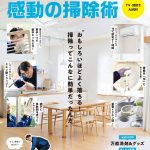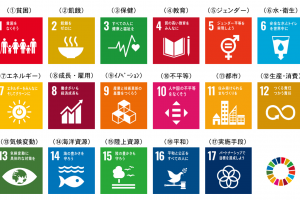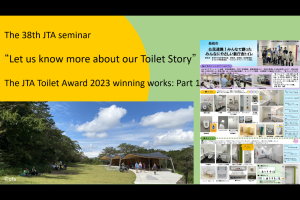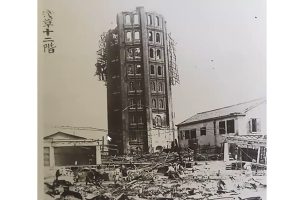ASEAN Public Toilet Standard
Issued on June 25 2012
クリックしてASEAN-Public-Toilet-Standard.pdfにアクセス
Commentary of this Standard
This standard guideline originated from ASEAN in 2012, and was compiled by the WTO, in Singapore as a guideline for public toilets to be used comfortably by the tourists.
This standard aims three goals: they are a standard for public toilets and a checklist used by auditors who evaluate compliance with this standard as well as the guidelines for architects and designers. However, it seems that the audit is still in the trial stage.
I. ASEAN PUBLIC TOILET STANDARD
1. Foreword
The objective of this standard is to develop an ASEAN Public Toilet Standard that can be implemented by ASEAN Member States to ensure the quality, comfort, safety and proper waste management of public toilets in general at touristic destinations within the ASEAN Region.
The development of the ASEAN Public Toilet Standard is in line with the ASEAN Tourism Strategic Plan (ATSP) 2011-2015. With reference to the previous toilet standard the resulting standard will still focus on four main criteria which are Design & Environmental Management System, Amenities & Facilities, Cleanliness and Safety (Fig.1).
2. Introduction
A basic yet vital component in the tourism industry that can make or break the tourist experience is when the tourist has to use the toilet. These toilets need to be clean, hygienic, and complete with various amenities and facilities, located conveniently, well maintained and using proper waste management systems. There are various types of toilets within the ASEAN region with different norms and designs. This standard looks at common criteria that should be practiced at all public toilets in the ASEAN region.
3. Scope
The Public Toilets Standard is divided into four main criteria which recommend how a public toilet should be maintained: Design and Environmental Management System, Amenities and Facilities, Cleanliness and Safety.
A public toilet as defined by this standard is a room or booth shared by all people at all times for urination and defecation consisting of at least a bowl fitted with or without a seat (seating or squatting) and connected to a waste pipe and a flushing apparatus.
This standard also focuses on public toilets frequented by tourists at places of interest/transit points/popular shopping areas.
II. ASEAN PUBLIC TOILET STANDARD – AUDIT CHECKLIST
A basic yet vital component in the tourism industry that can make or break the tourist experience is when the tourist has to use the Public Toilet. These toilets need to be clean, dry and hygienic, complete with various amenities, accessories and facilities, located conveniently, well maintained and equipped with a proper waste management system.
Public Toilets should also provide safe and accessible facilities to the public at an adequate level of privacy to perform the necessary sanitary functions. These facilities should also cater to the needs of people of different cultural needs and genders, all age groups and people with disabilities.
The development of an APTS (ASEAN Public Toilet Standard) is one of the measures developed within the framework of the ASEAN Tourism Strategic Plan (ATPS) 2011-2015. The ATPS 2011-2015 engages the ASEAN member states to develop and implement standardized tourism services essential for helping ASEAN to become a Quality Single Destination. The Task Force for the establishment of ASEAN Tourism Standards has identified six areas where standards, criteria, requirements and guidelines for certification need to be addressed, one of this being Public Toilets.
There are various types of toilets within the ASEAN region with different norms and designs. Also, the ASEAN region hosts countries with tropical weathers and high humidity levels and is home to various religions (i.e. Muslim toilet etiquette) and cultural habits influencing how the toilet is used (both squatting and seating habits, both washing and paper wiping habits).
This handbook has been compiled with the purpose of establishing a standard applicable to all Public Toilet premises in the ASEAN region, as a guideline to assist in the auditing of Public Toilets according to the ASEAN Public Toilet Standard (APTS) (as issued on June 25 2012), in short as a tool to improve the quality of Public Toilets and therefore of the tourism experience.
Acknowledgements
For the development and revision of this document we acknowledge the work done by ICC (International Code Council), WTO (World Toilet Organization), RAS (Restroom Association of Singapore), ATI (Asosiasi Toilet Indonesia), Dr Town Planner Clara Greed, British Toilet Association, British Standard Institute, ADA (American with Disabilities Act), Singapore BCA (Building and Construction Authority) and Singapore’s NEA (National Environment Agency).
Ⅲ. ASEAN PUBLIC TOILET STANDARD – AUDIT MANUAL
This APTS Auditor Manual is intended for use by Auditor Trainees who have attended the pilot APTS Auditor Training Module developed by World Toilet Organization and Brunei Tourism in August 2014 in Brunei. In this respect, it can be considered as a work in progress.
The Manual contains guidance on what is an APTS Audit and how to perform it on Public Toilets according to the APTS Standard.
This is the first Version (V.1 – August 2014) of the Manual. Other Versions will follow in accordance to changing needs and updates of the Standard (Fig.2).
IV. The APTS Auditor Role and Duties
The ASEAN Tourism Strategic Plan (APTS) Auditor, or the qualified individual who has received the relevant training and certification in order to be able to assess a Public
Toilet against the APTS standard, is responsible for ensuring an independent, evidence-based approach assessment.
The Auditor must adhere to the following Code of Conduct Rules:
• Keep confidentiality on all the information acquired pre, during and post Audit;
• Keep objectivity and an unbiased attitude in his/her assessing and reporting;
• Remain professional and maintain the observation of the highest standard of integrity;
• Refrain from communicating opinions or results throughout the assessment;
• Seek to maintain good professional relationships with stakeholders to promote free flow of information and be respectful throughout the entire Audit process;
• Report all significant instances of noncompliance that were found during or in connection with the Audit;
• Accept NO GIFTS in any form from Auditee Organizations or affiliates.
The Auditor must also adhere to the following Skills and Attire Rules:
• Possess adequate knowledge of the Standard subject matter and Audit techniques;
• Obtain sufficient and appropriate Audit evidence to satisfy the Audit objective, to be able to draw conclusions and to provide recommendations;
• Work systematically and carefully in interpreting the data and arguments collected and recorded;
• Complete the relevant Audit documents and produce Audit documentation to fully record the preparation, conduct, contents and findings of the Audit;
• Maintain the necessary decorum expected from a professional.
INDEX
I. ASEAN PUBLIC TOILET STANDARD
1. Foreword 1
2. Introduction 1
3. Scope 1
4. Terms & Definition 1
4.1. Public Toilet 1
4.2. Waste Management 2
4.3. Cubicle 2
4.4. Visitor 2
5. Criteria 2
5.1. Design and Environmental Management System 2
5.1.1. Good waste water management system and standardized water treatment system 2
5.1.2. Pleasant landscape and design 2
5.1.3. Clear public toilet signboards 2
5.1.4. Encourage the appropriate use of the toilet and importance of hygiene 2
5.1.5. Disabled and elderly facilities 2
5.2. Amenities and facilities 3
5.2.1. Appropriate space for each cubicle 3
5.2.2. Sufficient provision of amenities 3
5.2.3. Coat hangers and ledges in cubicles 3
5.3. Cleanliness 3
5.3.1. Adequate air circulation & ventilation system 3
5.3.2. Good smell and no dirty areas 3
5.3.3. Floors should be kept clean and dry 3
5.3.4. Trained personnel on the facility for cleaning and maintenance 3
5.3.5. Customers’ suggestion box 3
5.3.6. Regular cleaning and maintenance of the toilet premises 3
5.4 Safety 4
5.4.1. Adequate lighting 4
5.4.2. Public location 4
5.4.3. No slippery ground or surface 4
5.4.4. Firm construction 4
5.4.5. Cleaning Agent 4
II. ASEAN PUBLIC TOILET STANDARD – AUDIT CHECKLIST
1. Acknowledgements 7
2. Introduction 7
3. Objectives 8
4. Scope 8
5. Implementation 8
6. Terms and Definitions 9
6.1. Ambulant 9
6.2. Amenities 9
6.3. ASEAN Context 9
6.4. Audit Checklist 9
6.5. Backflow 9
6.6. Blind 9
6.7. Blind Audit 9
6.8. Corrective Action Log 10
6.9. Cubicle 10
6.10. Clean, Cleanliness 10
6.11 Cleaning 10
6.12. Disabled population 10
6.13. Fittings (a small part on or attached to a piece of furniture or equipment) 10
6.14. Fixtures (a piece of equipment or furniture which is fixed in position in a building) 10
6.15. Fixture supply 11
6.16. Inspection Card Toilet 11
6.17. Local government/authority/entity refers 11
6.18. Public Toilet 11
6.19. Reticulated sewerage system refers 11
6.20. Safe, safety 12
6.21. Self-Assessment Checklist 12
6.22. Toilet Suggestion Log 12
6.23. Toilet Visitor 12
6.24. Universal Design (UD) 12
6.25. Visually Impaired (of a patient) 12
6.26. Waste Management 12
7. Abbreviations 12
8. Criteria Guideline 13
8.1. Design and Environmental Management System 13
8.2. Amenities and Facilities 17
8.3. Cleanliness 20
8.4. Safety 21
9. Auditing Guideline 23
9.1. How the criteria in the audit are used for Public Toilets assessment 23
9.2. Audit Assessment Methods 23
9.3. Audit Process Flowchart 26
ANNEXES
Annex A Illustrations 29
Annex B Self-Assessment Checklist 35
Annex C Audit Checklist and Report 39
Annex D Corrective Remedy Plan 47
References 48
III. ASEAN PUBLIC TOILET STANDARD – CHECKLIST CRITERIA
IV. ASEAN PUBLIC TOILET STANDARD – AUDIT MANUAL
1. Introduction 57
2. Abbreviations 57
3. Terms and Definitions 57
3.1. Ambulant 57
3.2. Amenities 58
3.3. APTS Audit 58
3.4. APTS Auditors 58
3.5. ASEAN Context 58
3.6. Audit Checklist 58
3.7. Audit Criteria and Requirements 58
3.8. Audit Evidence 58
3.9. Audit Objectives 59
3.10. Audit Plan 59
3.11. Audit Procedures 59
3.12. Audit Report 59
3.13. Audit Scope 59
3.14. APTS Standard and APTS Audit Checklist & Guideline 59
3.15. Auditee 59
3.16. Backflow 59
3.17. Blind 59
3.18. Blind Audit 59
3.19. Corrective Action Plan 60
3.20. Cubicle 60
3.21. Clean, Cleanliness 60
3.22. Cleaning 60
3.23. Disabled population 60
3.24. Findings, Conclusions and Recommendations 60
3.25. Fittings (a small part on or attached to a piece of furniture or equipment) 60
3.26. Fixtures (a piece of equipment or furniture which is fixed in position in a building) 60
3.27. Fixture supply 61
3.28. Graffiti 61
3.29. Inspection Card Toilet 61
3.30. Local government/authority/entity 61
3.31. Nonconformity 61
3.32. (Public Toilet) Quality Management System 61
3.33. Public Toilet 61
3.34. Reticulated sewerage system 62
3.35. Safe, safety 62
3.36. Self-Assessment Checklist 62
3.37. Toilet Suggestion Log 62
3.38. Toilet Visitor 62
3.39. Universal Design (UD) 62
3.40. Vandalism 62
3.41. Waste Management 63
4. The APTS Standard 63
4.1. An Introduction 63
5. The APTS Audit 64
5.1. APTS Audit Characteristics 64
5.2. The APTS Audit and the Quality Management System 65
5.3. The Benefits of the APTS Audit 68
6. APTS Audit Types, Cycle and Steps 68
6.1. Types of APTS Audit and Audit Certification 68
6.2. The APTS Audit Cycle 69
6.3. The APTS Audit Steps 72
7. On-site APTS Audit in details 77
7.1. Auditor’s Equipment 77
7.2. APTS On-site Audit Standard Operating Procedure 77
8. APTS Audit Grading Methodology 77
8.1. APTS Audit Criteria and Requirements 77
8.2. APTS Audit Assessment Methods 78
8.3. Audit Process Flowchart 80
9. The APTS Auditing Tools and their use 82
9.1. The logic behind the APTS Auditing Tools 82
9.2. The APTS Auditing Tools 83
9.2.1. Self-Assessment Checklist 83
9.2.2. Audit Plan 84
9.2.3. APTS Audit Checklist 85
9.2.4. Corrective Action Plan 85
9.2.5. Audit Report 88
9.2.6. Working Papers (Notes Taking) 89
10. The APTS Auditor Role and Duties 89
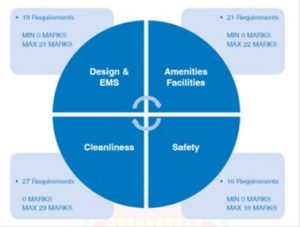
Fig.1 Four main criteria
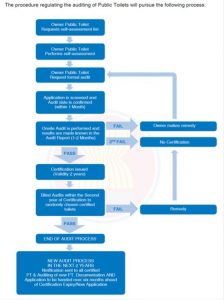
Fig.2 The audit procedure for public toilet,
References
ADA (American with Disability Act) A law enacted by the American Congress in 1990
encompassing a wide-ranging civil rights law that prohibits, under certain circumstances, discrimination based on disability (www.ada.gov)
ATI (Asosiasi Toilet Indonesia) an Indonesian-based organization devoted to raise awareness about sanitation issues in Indonesia. ATI works at various levels at national and subnational levels with the objective of advocating for better sanitation conditions with the objective of creating a cleaner, healthier and more environmentally friendly Indonesian society. ATI is official member of World Toilet Organization BCA (Building and Construction Authority) Singapore’s national authority under the Ministry of National Development, championing the development of an excellent built environment for Singapore. “Built environment” refers to buildings, structures and infrastructure in Singapore’s surroundings that provide the setting for the community’s activities.
BTA (British Toilet Association) is a UK-based Association devoted to represent the interest and aspirations of ‘away from home’ toilet providers, suppliers and users of all types and to act as the catalyst for change in the pursuit of standards of excellence in all areas of public toilet provision and management.
NEA (National Environment Agency) is Singapore’s national agency for regulating national environmental issues.
WTO (World Toilet Organization) founded in 2001, WTO is a global non-profit committed to improving toilet and sanitation conditions worldwide. On 24 July 2013, WTO achieved a key milestone for the global sanitation movement when 122 countries co-sponsored a UN resolution tabled by the Singapore government to designate 19 November World Toilet Day as an official UN day
【日本語訳】
アジアにおける公衆トイレ基準
2012年6月発行
クリックしてASEAN-Public-Toilet-Standard.pdfにアクセス
解説
この基準ガイドラインは,ASEANから発し,観光客を意識して快適な公衆トイレのガイドラインとして,2012年にシンガポールに本部があるWTOが中心となって纏めたものです.構成は,公衆トイレの基準と,それを元に基準準拠を評価する検査者が用いるチェックリストと,設計者向けのガイドラインの3要素から構成されています.しかし検査の実施状況は,まだ試行段階で終わっているようです.
I. アジアにおける公衆トイレ基準
この基準の目的は、ASEAN地域内の観光地での公衆トイレの品質、快適性、安全性、および適切な廃棄管理を確保するためのASEAN公共トイレ基準を策定することにあります。
この基準は、ASEAN観光戦略計画(ATSP)2011-2015に沿ったものです。 それ以前のトイレ基準と同様に、本基準では、「設計と環境管理システム」、「設備と付属品」、「清潔さ」、「安全性」という4点を主要な要素とします(図1)。
はじめに
観光産業において、観光客の好感度を左右する要素は、観光客がトイレを使用する時です。 これらのトイレは、清潔で衛生的で、さまざまな設備と付属品を完備し、便利で手入れが行き届き、適切な廃棄管理システムを使用している必要があります。 ASEAN地域には、さまざまな基準やデザインのトイレがあります。 ここでは、ASEAN地域のすべての公衆トイレで実施されるべき共通の基準として纏めました。
適用範囲
公衆トイレ基準としては、トイレの維持のため4つの主要な基準に分けられます。それらは「設計と環境管理システム」、「設備と付属品」、「清潔さ」と「安全性」です。
この基準で定義されている公衆トイレでは、排尿と排便のためにすべての人が常に共有する部屋またはブース(便房)であり、座席式またはしゃがむ式タイプで,水洗と排水管に接続されている装置の便器です。
この基準では、人の集まる場所,乗換え場所,人気のあるショッピングエリアで,観光客が頻繁に訪れる公衆トイレにも焦点を当てています。
II. 基準準拠のための検査チェックリスト
観光客の好感度を左右する重要な要素は、観光客が公衆トイレを使用する時です。 これらのトイレは、清潔で、床がドライで、衛生的で、さまざまな設備、付属品、設備を完備し、便利で、手入れが行き届き、適切な廃棄管理システムを備えている必要があります。
公衆トイレは必要な衛生機能を実行するために,公衆に適切なプライバシーで安全でアクセス可能な施設を提供する必要があります。 これらの施設は、さまざまな文化的ニーズや性別、すべての年齢層、障がい者のニーズにも対応する必要があります。
ASEAN公共トイレ基準(APTS)は、ASEAN観光戦略計画(ATPS 2011-2015)の枠組みに沿って策定されました。 ATPS 2011-2015の中では、ASEAN加盟国が、質の高い訪問先になる事を目指し,そのために観光サービスの開発や実施を支援します。APTSでの認証のために基準、要件、およびガイドラインに取り組む必要がある6つの分野を特定しました。そのうちの1つが公衆トイレです。
ASEAN地域には、さまざまな基準によるデザインのトイレがあります。 またこの地域は熱帯気候で湿度が高い所であり、トイレのエチケットなど,宗教によっても,しゃがむ習慣と腰掛ける習慣の違いも,またトイレットペーパーを使うか水で洗うかなど,文化的にも使用方法の違いがあります。
ASEAN公衆トイレ基準(APTS)(2012年6月25日に発行)に従って公衆トイレの検査を支援するためのガイドラインとする位置づけの,この基準書は、観光体験の品質を向上させるためのツールとして,ASEAN地域のすべての公衆トイレ施設に適用される基準を確立することを目的として編集されました。
謝辞
このチェックリストの作成に当たり、ICC(国際コード評議会)、WTO(世界トイレ機構)、RAS(シンガポールトイレ協会)、ATI(アソシアシトイレインドネシア)、英国トイレ協会、英国標準研究所、ADA(アメリカ障がい者法)、BCA(シンガポール建設庁)、NEA(シンガポール国家環境庁)の協力を得ました。
Ⅲ. ASEAN公共トイレ基準-検査マニュアル
本APTS基準・検査マニュアルは、2014年8月にブルネイで世界トイレ機構(WTO)とボルネオ観光局が開発したAPTS審査員試行トレーニングに参加する基準・検査の研修生が研修の為に使用することを目的としています。 その意味では、本マニュアルは未完成な段階です。
本マニュアル(V.1- 2014年8月)には、APTS検査の役割と,APTS標準に従って公衆トイレで検査を実施する方法に関するガイダンスが含まれています(図2)。
Ⅳ. APTS検査役の役割と義務
ASEAN観光戦略計画(APTS)検査役、またはAPTS基準による公衆トイレを評価の関連する訓練と認定を受けた資格者は、評価して保証する責任が発生します。
検査役は、以下の行動規範規則を遵守する義務があります。
•検査前後で取得したすべての情報の機密を保持すること。
•評価と報告において客観性と公平な態度を保つこと。
•専門家であり続け、最高水準の誠実さの遵守を維持すること。
•評価中に意見や結果を伝えることを控えること。
•自由な情報の流れを促進し、検査プロセス全体を通じ、利害関係者との良好な専門的関係を維持するよう努めること。
•検査中または検査に関連して,すべての発見されたコンプライアンス違反の事例を報告すること。
•被検査組織または関連会社からのいかなる形の贈与も受け付けないこと。
検査役は、次の技術と服装のルールを遵守すること。
•標準的な主題と検査手法に関する十分な知識を保持すること。
•検査の目的を満たし、結論を導き出し、推奨事項を提供できるようにするために、十分かつ適切な検査証拠をしめすこと。
•収集および記録されたデータと議論の解釈に体系的かつ注意深く取り組むこと。
•検査文書を作成して、準備、実施、内容、および調査結果を完全に記録すること。
•専門家に期待される必要な礼儀を尽くすこと。
目次
I.ASEAN公共トイレ基準
1.まえがき
2.はじめに
3.適用範囲
4.用語と定義
4.1 公共トイレ
4.2 廃棄管理
4.3 部屋またはブース(便房)
4.4 訪問者
5.基準2
5.1 設計・環境管理システム
5.1.1 優れた廃水管理システムと標準化された水処理システム
5.1.2 心地よい景観とデザイン
5.1.3 公共トイレ看板
5.1.4 トイレの適切な使用と衛生の重要性
5.1.5 障がい者施設および高齢者施設
5.2 設備と付属品
5.2.1 各部屋または個室の適切な空間
5.2.2 付属品の提供
5.2.3 部屋または個室のハンガーと棚
5.3 清潔さ
5.3.1 適切な空気循環と換気システム
5.3.2 無臭、清潔さ
5.3.3 床は清潔で床がドライの状態に保つこと
5.3.4 清掃と補修のための施設要員
5.3.5 顧客向け提案箱
5.3.6 トイレの定期的な清掃と補修
5.4安全性
5.4.1 照明
5.4.2 公共場所
5.4.3 滑りやすい地面や表面
5.4.4 堅固な構造
5.4.5 洗浄剤
II ASEAN公的トイレ基準-検査チェックリスト
1.謝辞
2.はじめに
3.目的
4.適用範囲
5.実装
6.用語と定義
6.1 救急車
6.2 付属品
6.3 ASEAN利用文脈
6.4 検査チェックリスト
6.5 逆流
6.6 ブラインド
6.7 ブラインド検査
6.8 是正措置ログ0
6.9 部屋またはブース(便房)
6.10 清潔さ
6.11 清掃
6.12 障がい者人口 分布
6.13 付属品(家具または設備の一部に取り付けられている、または取り付けられている小さな部品)
6.14 備品(建物内の所定の位置に固定されている機器または家具)
6.15 備品供給
6.16 検査カード
6.17 地方自治体/当局/団体
6.18 公共トイレ
6.19 網状下水道
6.20 安全、安全
6.21 自己評価チェックリスト
6.22 トイレ提案ログ
6.23 トイレビジター12
6.24 ユニバーサルデザイン(UD)
6.25 視覚障がい者
6.26 廃棄管理
7.略語
8.基準ガイドライン
8.1 設計および環境管理システム
8.2 設備と付属品
8.3 清潔さ
8.4 安全性
9.検査ガイドライン
9.1 検査の基準と公衆トイレの評価
9.2 検査評価方法
9.3 検査プロセスのフローチャート
付属書
付録Aイラスト
付録B自己評価チェックリスト
付録C検査チェックリストおよび報告書
附属書D是正措置計画
参考文献
III. ASEAN公共トイレ基準-チェックリスト基準
IV. ASEAN公共トイレ基準-検査マニュアル
1.はじめに
2.略語
3.用語と定義
3.1 救急車
3.2 付属品
3.3 APTS検査
3.4 APTS検査人
3.5 ASEANの状況
3.6 検査チェックリスト
3.7 検査基準と要件
3.8 検査証拠
3.9 検査目的
3.10 検査計画
3.11 検査手順
3.12 検査報告書
3.13 検査範囲
3.14 APTS標準およびAPTS検査チェックリストとガイドライン
3.15 被検査者
3.16 逆流
3.17 ブラインド
3.18 ブラインド検査
3.19 是正措置計画
3.20 部屋またはブース(便房)
3.21 清潔さ
3.22 清掃
3.23 障がい者人口
3.24 調査結果、結論、および推奨事項
3.25 付属品(家具または設備の一部に取り付けられている、または取り付けられている小さな部品0
3.26 備品(建物内の所定の位置に固定されている機器または家具)
3.27 備品供給
3.28 グラフィティ
3.29 検査カードトイレ
3.30 地方自治体/当局/団体
3.31 不適合
3.32 (公共トイレ)品質マネジメントシステム
3.33 公共トイレ
3.34 網状下水道
3.35 安全
3.36 自己評価チェックリスト
3.37 トイレ提案ログ
3.38 トイレビジター
3.39 ユニバーサルデザイン(UD)
3.40 破壊行為
3.41 廃棄管理
4.APTS標準
4.1 はじめに
5.APTS検査
5.1 APTS検査特性
5.2 APTS検査と品質マネジメントシステム
5.3 APTS検査の利点
6. APTS検査の種類、サイクル、およびステップ
6.1 APTS検査および検査認証の種類
6.2 APTS検査サイクル
6.3 APTS検査ステップ
7.オンサイトAPTS検査の詳細
7.1 検査人の設備
7.2 APTSオンサイト検査標準操作手順
8.APTS検査評価方法
8.1 APTS検査基準と要件
8.2 APTS検査評価方法
8.3 検査プロセスフローチャート
9.APTS検査ツールとその使用
9.1 APTS検査ツールの背後にあるロジック
9.2 APTS検査ツール
9.2.1 自己評価チェックリスト
9.2.2 検査計画84
9.2.3 APTS検査チェックリスト
9.2.4 是正措置計画
9.2.5 検査報告書
9.2.6 ワーキングペーパー(メモを取る)
10.APTS検査人の役割と義務


